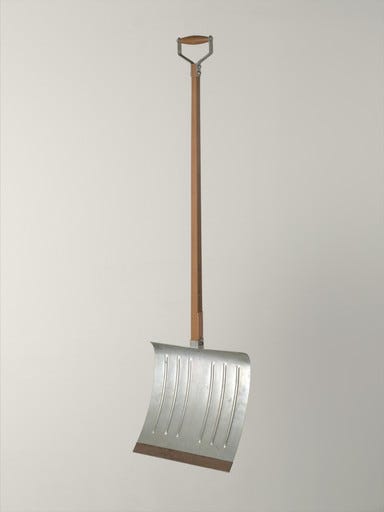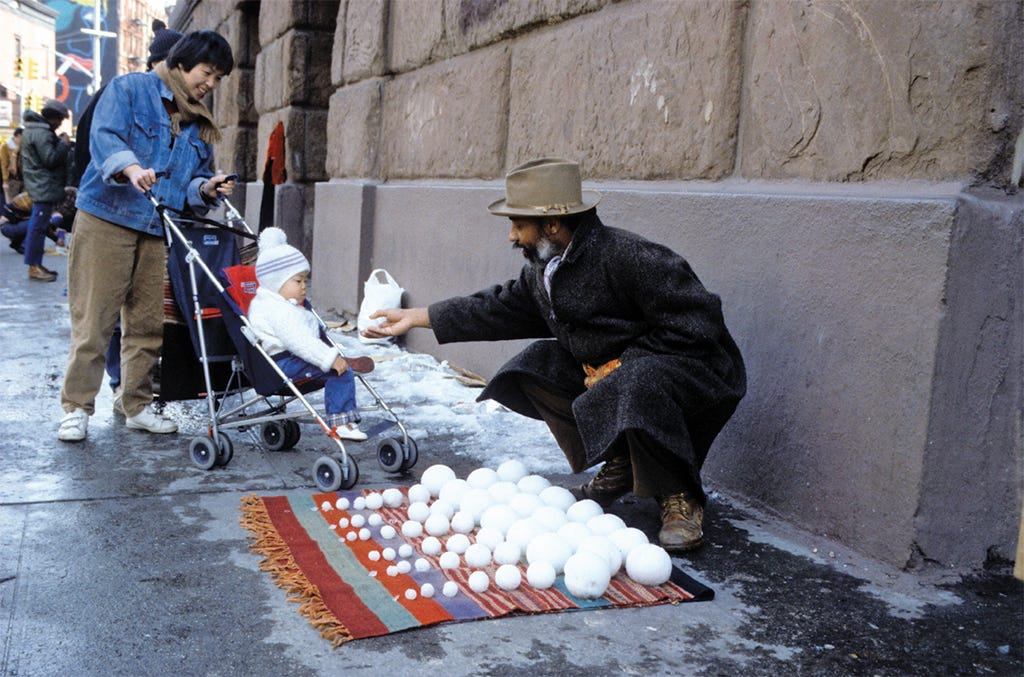Let It Snow!
"Snowflake"- Kate Bush
We’re currently in the middle of a snowstorm here. Winter had been mild— a little too mild— but the cold snap snapped, and here we are. Although I hate this meteorological phenomenon more than pretty much anything, I am relieved to be experiencing this normal winter thing during winter. Frankly, I struggle a lot with eco-anxiety, and unseasonable weather wreaks havoc with my mental health. What can I say, I am a delicate flower! Which is unfortunate, because like most flowers, I do not thrive in the snow. One arena of life in which I do thrive, however, is looking at and thinking about art, so maybe it will soften the blow to combine my purest hate with my deepest love. Let’s give it a shot, shall we?
Today I wanna look at some works that use snow as artistic medium. Obviously, I’m cherry picking because it’s my newsletter and I’m gonna write about what I wanna write about, but there are definitely a lot of other artworks I could have included. This is not exhaustive, is what I’m saying. Here we go:
First up, a work that doesn’t actually feature snow, but merely implies its presence. Yes, it’s my man Marcel Duchamp’s In Advance of the Broken Arm from 1915. This common snow shovel, purchased, hung from the ceiling, and provocatively titled, is an early example of that category of art pioneered by Duchamp, the readymade, in which an everyday object is elevated to the status of art by a mystical process known as just no longer using it for its intended purpose. By denuding the shovel of its utilitarian function, Duchamp explores the nature of art— is it not art at the hardware store, but art in the studio or gallery? Is it art if I say so? Is art making things, or could it be something else? While this work is not technically the first of these conceptual forays (that honor goes to 1913’s Bicycle Wheel), I like this one precisely because the title is so evocative. Looking at it, we think about using the shovel on the treacherously slick sidewalks where folks risk life and limb (well, mostly limb) to clear a path in what I like to think of as Satan’s carpet. Duchamp’s phrasing in that title, ‘In Advance of,’ implies that a previously dangerous, threatening implement has been rendered safe through his interventions. It could have gone a different, more painful way— in fact, it most assuredly would have, but you don’t have to worry anymore. Now, the only threat is to our comfortable preconceived notions of what exactly constitutes art, which also feels pretty dangerous, if not likely to result in a trip to the ER.
Next up, David Hammons’s Bliz-aard Ball Sale from 1983, in which the artist has created snowballs of varying sizes, arranged them aesthetically on a blanket, and posted up on a New York City sidewalk as a street vendor. While I typically find Hammond’s oeuvre conceptually compelling but hit-or-miss in its execution, this performance is a hit for me. As anyone who’s been with me since the podcast days knows, I’m a sucker for art that brings it to the people. Art in everyday life, art that reaches out and changes people’s day, mind, heart, future. Work of this type, when pulled off well, strikes a balance of earnestness about its artistic goals with not taking itself too seriously. Of course, Hammons is doing a lot here— certainly more than we have space to get into in this forum— but most overtly he’s touching on that intersection of the commodification of art and the ephemerality of much art-making of the time. How do you sell something that only exists as finite, intimate, immediate? You can hold it in your hand, but only fleetingly. Of course, these considerations extend to Hammons’ performance, as well, which lives on only through photographs. The work Bliz-aard Ball Sale is long past, like the puddle of water where a snowball once was. Ok, so maybe it’s not that profound, but it approaches its subject with whimsy, and I like that.
From two artists whose practices are largely disinterested with facture we come to an artist whose work is about little else. That might be taking it a bit far, but truly, the process of creation itself, tactility, the felt sense, is the essential element that makes Andy Goldsworthy’s art engrossing. Goldsworthy’s earthworks or “land interventions” seem tailor-made for the internet age, though his entire thing predates it by decades. Still, the more the masses love him, the more museums love him for his commercial appeal and the less the scholarly artworld takes him seriously. Tale as old as time— if too many people like your work, it becomes immediately suspect to art insiders & elites. Fine, I understand that it’s not doing a bunch intellectually, and that it’s too decorative, too pretty to provide that frisson of resistance or challenge that truly transcendent art elicits (supposedly…). But the making of it! That’s the good stuff. Goldsworthy has worked with snow and ice a lot, and his installations, by their very nature, are temporary. Much of what he’s doing is for no one else. He’s outside in the fucking freezing cold, in fingerless gloves so he can feel the material he’s working with, building and manipulating and coaxing and problem-solving on the fly.1 Whether he’s working with leaves or twigs or icicles, he’s becoming familiar with his medium in that moment— how does it behave and what are its limitations? What can it do? He’s trying and failing and he’s starting over and failing and failing and failing and starting again. It’s the making, it’s the seeing if he can do it, and what if he can? A small victory, a snapshot of something that looks cool, and on to the next one. In the words of one Kimberly Kardashian, “Get your ass up and work.” And he does.
Swiss duo Fischli/Weiss used a range of media & methods in a body of work that has much in common with those of each of the artists discussed above: the everyday world plumbed by Duchamp, the whimsy of Hammons, and themes of the natural world found in Goldsworthy. We’ve got a bit of all three in their sculptural installation Snowman. First conceived in 1987 in Germany, the original used energy from a power plant to pump humidity into the vitrine where ice formed over a copper structure creating the distinctive snowman form. The work would last in perpetuity by continuing to utilize energy generated by the plant. There are, of course, many avenues one can take this— a sort of man vs. nature vibe, themes of climate change and deliberately making something that our energy use is actively eradicating, taking something we associate with childhood and removing the hand completely— it’s no longer play, it’s science. I think any one of us might take it to a different place. There’s a part of me that looks at that and just sees human folly. The version created in the ‘10s that sits on a museum terrace feels in some ways to me utterly banal. Look, it’s a cold thing in a hot place! Without the power plant to provide the energy, we’re just looking at the equivalent of a window a/c unit. Maybe I’m being too cynical, I don’t know. But you have to admit, that fucker looks evil. Look at its face.
you just have to wonder2
If you’ve never seen Rivers and Tides (Riedelsheimer, 2002), a documentary about Goldsworthy at work, you can watch it for free on Tubi and I highly recommend. It’s a fun watch, for real! There’s one moment in the film that produced an audible reaction from my classes every single time I showed it. You’ll probably know when you see it.
I started writing this post a couple years ago and it’s been languishing in the drafts unlooked-at and unremembered since then. I have no idea what I was about to say in that last fragment (“you just have to wonder”) but I’m leaving it as is, because you do indeed just have to wonder, don’t you? I know I do. I hope if you’re in the path of this storm you are staying safe and snuggled in. I hope if you’re not in the path of this storm you stub your toe later because I am seething with jealousy and I’d like you to suffer a little bit just out of spite.





